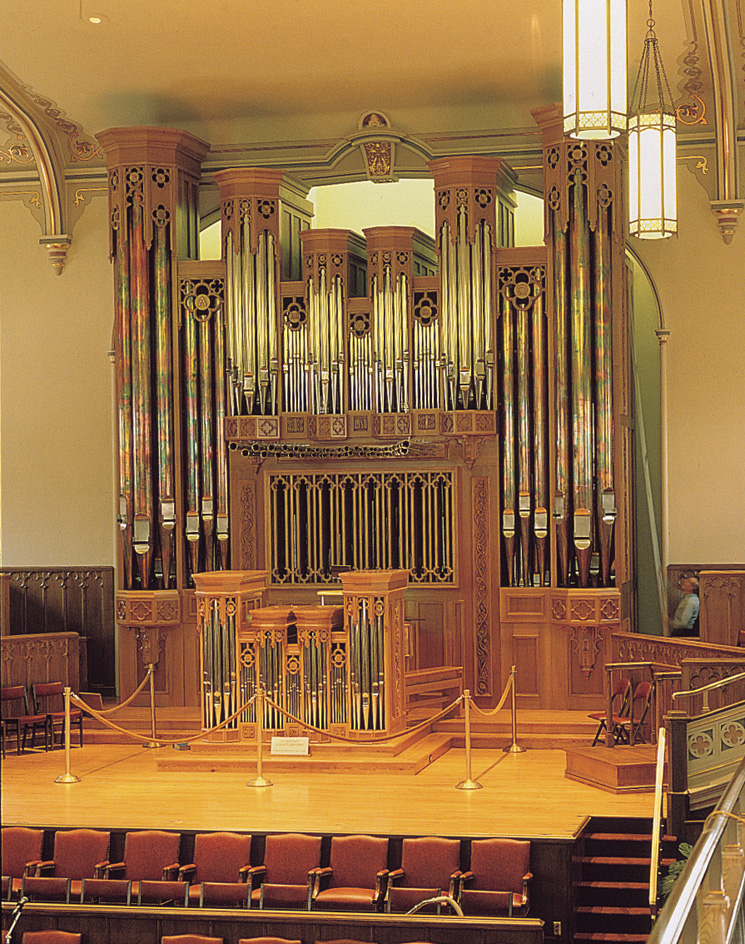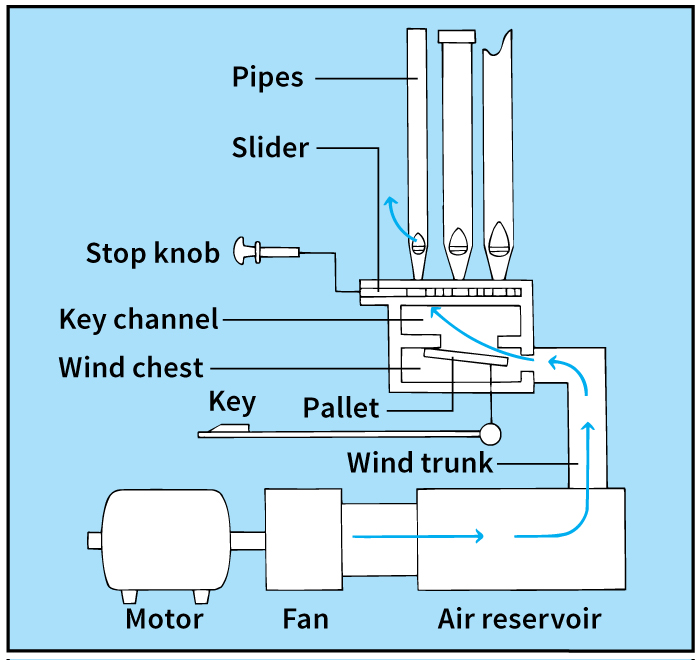Organ is a keyboard musical instrument. There are two chief kinds of organs, pipe organs and electronic organs. Most pipe organs are found in churches, concert halls, and theaters. The history of the pipe organ can be traced back to the 200’s B.C. Many masterpieces of music have been composed for the pipe organ.
The electronic organ was invented in the mid-1900’s. Most performers consider the pipe organ superior to the electronic organ. However, electronic organs are popular instruments in the home, and many churches also have them. The electronic organ ranks behind only the piano and the guitar as the most widely played instrument in the United States.
Both the pipe organ and the electronic organ have one or more keyboards that resemble a piano keyboard. However, the instruments produce sounds differently. A piano makes sounds by causing steel strings to vibrate. A pipe organ creates sounds by forcing air through metal or wooden tubes called pipes. An electronic organ produces sounds by means of electrical signals.
A pipe organ is the largest and most powerful of all musical instruments. Many pipe organs are so large that they must be built as part of the building where they are to be used. A large pipe organ can produce effects of grandeur that even a symphony orchestra cannot duplicate. It also can play delicate and refined music.
Pipe organs.
A small pipe organ has only a few hundred pipes, but a large organ has more than 5,000 pipes. Most pipes are made of lead or of lead mixed with tin. Some are made of other metals or wood.

An organist creates music by combining the sounds of different ranks (rows) of individual pipes. Each pipe in a rank is tuned to a single pitch and produces only one musical tone. Some ranks are pitched one or two octaves higher or lower than others.
Loading the player...
Pipe organ

Most organs have two types of pipes—flue pipes and reed pipes. A flue pipe works like a simple whistle. Air enters from a hole in the bottom of the pipe and causes a column of air inside the pipe to vibrate. The vibration creates the sound. A reed pipe contains a thin brass reed that vibrates as air passes around it.
About 80 percent of the pipes in an organ are shaped like cylinders. But no two pipes of an organ look or sound exactly alike. The shape and size of the pipe determines the sound it makes. The longest pipes, which produce the lowest notes, may be more than 30 feet (9 meters) long and 1 foot (30 centimeters) in diameter. But most pipes measure less than 4 feet (1.2 meters) long. The smallest pipes, which produce the highest notes, are only 7 inches (18 centimeters) long and less than 1/4 inch (6 millimeters) in diameter.
Most pipe organs have one, two, or three keyboards. A few have as many as six. The additional keyboards enable the organist to create a wide variety of musical effects. The keyboards played with the hands are called manuals. Large organs may have up to five manuals called, in order of importance, the great organ; swell organ; positive, or choir, organ; solo organ; and echo organ. Most organs also have a pedalboard, a keyboard played with the feet. Each keyboard—manuals and pedalboard—operates a number of ranks. Every key controls several pipes. All the ranks operated by a keyboard are arranged on a wind chest, a box that receives an even flow of wind (air) from a reservoir. An electrically powered fan fills the reservoir with wind.
A thin strip of plastic or wood called a slider lies under each rank of pipes on a wind chest. A slider has holes in it that match the number and size of the holes in the rank of pipes above it. A slider regulates the passage of wind into the pipes. Sliders are controlled by stop knobs, commonly called stops, near the manuals. By pulling a stop, the organist moves the slider into position beneath the pipes so that wind can enter them.
To let wind into certain pipes, the organist presses the key that controls those pipes. This action opens a valve called a pallet in the wind chest and allows wind to flow into a compartment called the key channel. Wind enters the pipes from the key channel.
A cabinet called a case encloses all the pipes on a wind chest. It blends the sounds of the pipes and projects this combination of sound out of the organ.
Electronic organs
have no pipes. Devices called oscillators generate an electric current that produces the tones. The organ’s sound is amplified electronically. An electronic organ cannot create the variety and richness of sound that a pipe organ can. But it costs less and requires less space. The electronic organ has become a popular instrument in the home. It also is widely used in jazz and rock music. The synthesizer is a modern keyboard instrument capable of imitating the sounds of many other instruments. See Synthesizer.
History.
In the 200’s B.C., Ctesibius of Alexandria, a Greek engineer, built an organ that was called a hydraulis, or hydraulus. This organ used water power to force air into the pipes. Organs that used a bellows first appeared in Byzantium (now Istanbul, Turkey) during the A.D. 100’s and 200’s. The major features of the modern organ were developed from the 200’s to the 1500’s. The keyboard was developed by the end of the 1400’s.
From the 1500’s to the mid-1700’s, many composers wrote organ masterpieces. The greatest of these composers was Johann Sebastian Bach of Germany. Other leading organ composers included François Couperin of France and Girolamo Frescobaldi of Italy. During this period, organists accompanied singers in operas and in oratorios. Large organs were played in churches. Small organs were popular at home and at public events.
By the late 1700’s, small organs had lost their popularity. Many composers believed an orchestra or a piano could provide a wider range of musical effects. By 1900, interest in the organ had declined among composers and performers. The instrument was played regularly only in churches as part of religious services.
A revival of interest in the organ began during the early 1900’s. The German humanitarian Albert Schweitzer, an accomplished organist, began this revival. He gave concerts in many European cities and stimulated interest in the instrument. In 1934, Laurens Hammond, an American inventor, patented the first commercially practical electronic organ.
